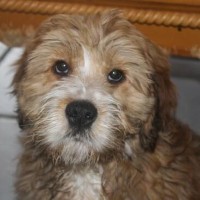Appearance of the Clumberton
|
| A Clumberton is a small to medium-sized dog that resembles a more gangly Clumber Spaniel with some Bedlington facial features. Clumbertons average 16 to 20.5 kilos in weight and grow to 40.5 to 46 centimeters in height. They have a short, wavy coat whose texture lies somewhere between the dense hair of the Clumber Spaniel and the soft fur of the Bedlington Terrier. Clumbertons come in a wide variety of colors; this breed can be any combination of blue, liver, sable, beige or white with the possibility of lemon or orange markings. Its Terrier genes give the Clumberton a shorter skull and longer jaw with little definition between the forehead and nose, which is usually black or dark brown. It has relatively broad legs with thick, smooth pads. The breed's eyes are almond-shaped, wide and dark, while its medium-sized ears are floppy and low on either side of its head. |
Temperament of the Clumberton
|
| Clumbertons are affectionate, loyal and intelligent. They are people-oriented pets who become very attached to their owners and seek human attention whenever possible. Clumbertons can be wary of strangers and other animals, so introductions to new friends, furry or otherwise, should be made slowly and thoughtfully. However, Clumbertons are not known for being aggressive towards other animals or for barking frequently. The breed can be slobbery and is known for nipping and play biting. As a result, Clumbertons may be better suited to families without children or to older children. They're an intelligent breed that responds well to training, and like most breeds, early and consistent discipline is the best way to raise a well-adapted animal. Beyond that, Clumbertons can be lively, energetic dogs. They love to play outside with their owners and other dogs, but they also enjoy being indoors and relaxing with their family. |
Needs and activities of the Clumberton
|
| Clumbertons can be agile, energetic dogs, although they require only light exercise. This breed will settle for a moderate daily walk and/or play session with owners or other dogs if the Clumberton is friendly with other animals. They also like to romp around indoors to burn off energy. Given their flexibility, Clumbertons can live comfortably in urban, suburban or rural environments if they have enough outdoor space to stretch their legs. What's more, this breed will do well in any type of climate, but like all dogs, they shouldn't be over-exercised in hot weather. In the evening, Clumbertons make cuddly couch companions after an active day. |
Maintenance of the Clumberton
|
| Clubmertons are not completely hypoallergenic, but produce fewer allergens due to the coat type they inherit from their Bedlington Terrier parent. This breed is a moderate shedder and should be brushed a few times a week. Clumbertons should be bathed monthly, and owners should pay particular attention to cleaning their floppy ears to avoid infections in this area. If the coat is longer around the eyes and feet, clipping is recommended. Clumberton owners who take inspiration from their parent Terrier breed may need professional grooming to tame a curlier coat. Like all dog breeds, Clumbertons should have their teeth brushed daily and their nails trimmed once or twice a month to avoid painful overgrowth. |









 English (United Kingdom)
English (United Kingdom)